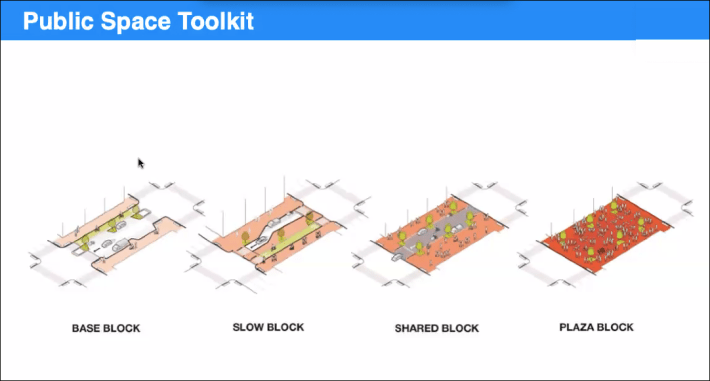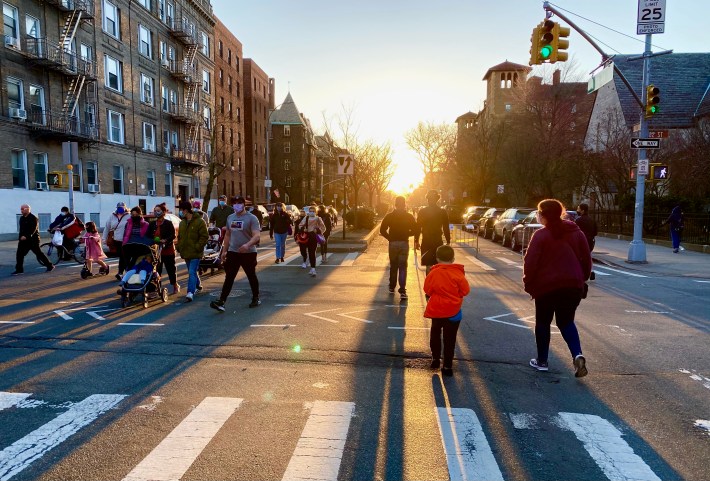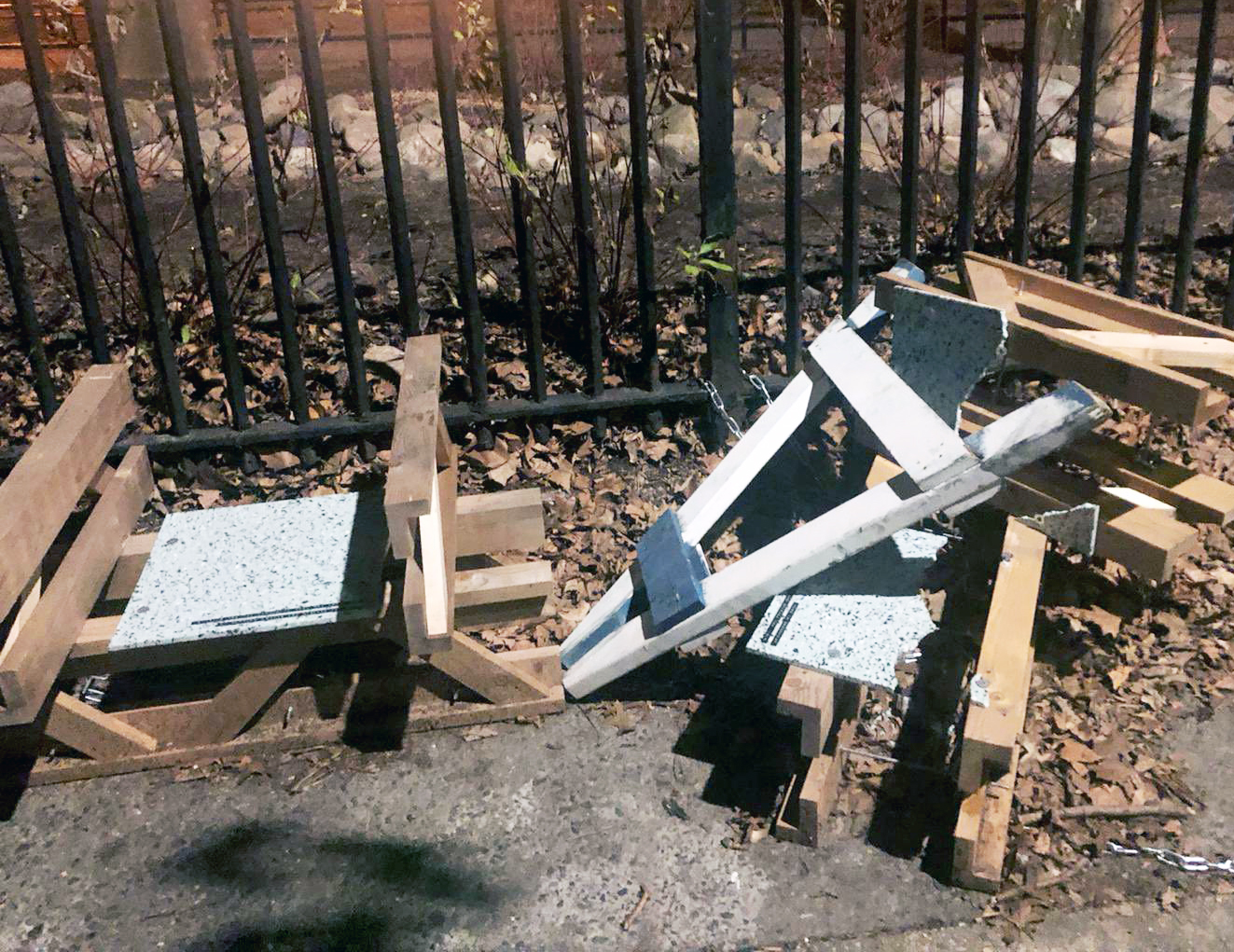Open streets — open question.
The de Blasio administration is at risk of squandering its impressive open streets initiative just as it is supposed to be made permanent — failing to fill the vacuum created as community groups are struggling with material costs, volunteers are drifting away and car owners are moving to reclaim the few metaphorical inches of space that the city repurposed for healthy recreation during the COVID pandemic.
The mayor last year said his open streets program — a haphazard collection of roughly 70 miles of street segments across all five boroughs — would be a permanent addition to the streetscape. But the mayor has never defined what shape that permanent open space would take and how it will be fostered so that it doesn't merely rely on thousands of volunteers setting up and removing barricades every day, replacing them when they are vandalized or damaged by car drivers, and dealing with hostilities from motorists who don't understand the program.
The Department of Transportation has held a series of "visioning" sessions to discuss the future of some open streets — specifically Jackson Heights's 34th Avenue and North Brooklyn's connected open streets — but those sessions have failed to project any mayoral vision. Instead, they have been an exploration of the "toolkit" available to communities (which range from a fully pedestrianized street to merely getting more park benches added to the sidewalk) and a chance for car owners to complain about what they see as a loss of "their" space.
There is constant talk at these sessions about "compromise," but even the definition of that word is unclear; car owners think a "compromise" is reducing the hours of the open streets (currently 8 a.m. to 8 p.m.) or eliminating them altogether, while supporters of open streets believe that the half-day hours are themselves the compromise from what the community really needs: a small linear park reclaimed, 24-7-365, from New York City's 6,000 miles of roads.
And many of the visioning sessions end up inflating a small problem that a small minority of people think is evidence that the program has failed — such as the increase in trash that comes from creating fully pedestrianized space — rather than celebrating something good that can and should be easily improved.
In one visioning session on 34th Avenue, the DOT presented statistics — first reported by Streetsblog — that the open street in Jackson Heights had reduced injuries from car crashes by 85 percent. That stat alone should be a game-changer — yet not a single person in any of the breakout sessions referenced it. And the DOT, which constantly touts a "safety-first" mantra, did not use the statistic to bolster a position in support of a true open street.
Nor did the agency push back on some car-owners concerns that the open street isn't popular — the agency's own surveys show that 76 percent of respondents said their enjoyment of the neighborhood has increased as a result of the open street.
Here's a rarely discussed upside to @NYCMayor and @nyc_dot open streets program: ROADWAYS WITHOUT CARS ARE MUCH SAFER! It's basic math: https://t.co/7mR15wDO26 (H/T to @jessicaramos @noneck @JimRockaway @radlerkoenigin @SophieMaerowitz and others who fight for safe streets).
— Streetsblog New York (@StreetsblogNYC) February 3, 2021
The agency's timeline will extend well into the summer, as it still needs to present a draft of a plan stemming from the multiple visioning sessions to the community board, whose chairwoman Renetta English has said that she looks forward to hashing it out, and has taken pains to say that her panel was offended that it was not consulted on open streets in the first place. (Can't wait for those meetings!)
Where is the mayor?
On Tuesday, Streetsblog asked Mayor de Blasio why he has not forcefully offered his vision for permanent open streets — including on 34th Avenue, which his own DOT calls "the gold standard" — and whether he is concerned if that vacuum of leadership will lead to open streets that aren't as good as they could be.
"I think there'll be different approaches for different places," he said. "Some might be more temporary, some more permanent, some bigger, some smaller. ... In some cases, absolutely, we'll have a permanent pedestrian plaza. In other cases, it might be different times of the week. So, what I like is the idea of tailoring it to each neighborhood."

He did say that he is aware that car owners are complaining, but promised to push back.
"I'm not surprised that there are complaints, but this is for the greater good," he said. "This is about creating communities that work for everyone and encourage people to be outside and benefit folks who can't afford a car. So, we're going to keep expanding, but it will really be done neighborhood by neighborhood, depending on the specific needs of each neighborhood."
It's a classic de Blasian answer: It sounds substantive, but then it fades into can-kicking. We can act boldly, the mayor is saying, but let's first wait until we hear what change-resistant communities tell us. In Jackson Heights, many are telling him to create a true pedestrian open space resource. And, yes, a few are telling him not to do that because 34th Avenue is such an important east-west roadway (that happens to be one block from Northern Boulevard). So what are the "specific needs" of Jackson Heights?
The haves and have nots
Of course, some neighborhoods are wealthy and some neighborhoods aren't. Streetsblog has learned that many communities are actively raising money through GoFundMe and other charity platforms — which raises the concern that well-to-do neighborhoods will have the resources to keep their open street program going, but others will not.
The Prospect Heights Neighborhood Development Coalition, for example, raised more than $20,000 in just a month on GoFundMe from residents of the tony Brooklyn neighborhood to support the open restaurant street on Vanderbilt Avenue. The money is necessary "to hire resources to marshal the event, and add an events program for artists hoping to earn income on the avenue ... purchase equipment (barriers, signage) and supplies, and plan to launch with a communications campaign with direct mail to all of the neighborhood."
The Fifth Avenue BID in neighboring Park Slope also raised $21,000 on Donorbox because "the city did not provide any operating funds to help us. These costs include staff, more barricades, signage and insurance.
Such efforts can be seen as a triumph of community organizing and support — but they can also reveal the frustration of volunteers who have basically been put in the position of making sure a major city initiative doesn't fail.

"We're getting no support," said Jim Burke, a leader of the massive 34th Avenue volunteer effort, which includes not only setting up and maintaining barricades, cleaning the area, programming the open street with Zumba, yoga and meditation classes, and even handing out bike helmets when the DOT couldn't. The 34th Avenue open street from Junction Boulevard to 69th Street has become the "gold standard" (as the DOT constantly calls it) because of that volunteer effort.
"We're happy to do it, but all our volunteers are stretched thin," Burke said. "These are the same people who are handing out food at the food pantry, plus working every day. We can't keep going to the same well of volunteers. We bought the city time at the start to get this right, but now we need the city to step up."
Burke said at the very least, a major public space initiative should include a public component — such as DOT crossing guards who would be responsible for setting up and taking down the barricades and coordinating with agencies such as Sanitation when there are issues.
Again, where's the mayor?
Streetsblog asked him about it on Monday — and his answer suggests a thin depth of thought on his part (in fairness, we might have been giving him information he had not heard before):
Question: We’ve learned that there are multiple community groups, now these are not business improvement districts, these are just community groups, that are actually raising money on GoFundMe and other charity platforms to help raise money to operate their open street, which is kind of a bizarre circumstance because open streets are, by definition, public space, carved out by you and your administration for the benefit of the communities. So ... if a community is raising money to help set up its open street, that raises the possibility that communities with substantial means like the Upper West Side of Manhattan, might be able to raise money to keep its open street going, whereas another community that might not have the means to do so, wouldn't be able to do that. You ran as a mayor to fight the tale of two cities. So, where do you stand on [that]?
Mayor de Blasio: I think we have to recognize that until a week ago, we were dealing with a situation of tremendous financial scarcity and limits. And in that context community groups stepping forward and doing whatever they could to support the efforts made sense. I think now we have a chance to reevaluate because of the stimulus funding and see if there's some ways we can provide more support. I can't say yet exactly what that will be, because as you can imagine, the moment we have these new resources we have immense need and demand that we have to address and all the previous deficits we're trying to make up. But I think it's a fair question. I really do. I want to make sure that open streets reach every kind of community and that the financial realities of community groups don't hold them back from being able to participate. So, we obviously have to look at solutions there, whether it's public funding or foundation funding or whatever it may be to ensure that open streets is something for everyone and for every kind of community. So, it's a fair concern, thank you for raising it.
It's not that de Blasio's answer was poor — but it did raise eyebrows among open streets volunteers.
"I appreciate that the mayor is acknowledging the material support volunteer groups need, but mentioning 'competing interests' for that funding is a way of saying, 'We’re not sure this is an essential need,'” said Sophie Maerowitz, co-founder Loisaida Open Streets Community Coalition. "And that’s concerning because car owners on my community board and neighbors opposed to open streets have been framing our efforts as 'for fun' or 'just a temporary thing' when in reality, car-free public space is a dire public health need, whether we’re talking about car crashes or lack of clean air and green space."
To Maerowitz, the current limbo is especially frustrating because she, like Burke, is finding herself "in survival mode" every day as she deals with her laundry list of daily crises: "broken barriers, making sure there’s someone to move barricades for emergency vehicles every single hour of our programming, reassuring volunteers when an aggro driver or NIMBY neighbor is on the prowl (or trolling us on social media, which I can’t even begin to deal with!)."
Transportation Alternatives, which is leading a larger coalition of open street volunteer groups, saw some things to be optimistic about.
“It’s very good news that the mayor is open to allocating public funding so open streets can grow and serve neighborhoods equitably," said Erwin Figueroa, TA's director of organizing. "We urge him to make this a priority in our city budget, now that it’s had a significant influx in federal dollars, so we can install permanent infrastructure on streets, pay for the labor of local groups that make the program come to life, and operate open streets 24/7 year round.”
What's it like on the street?
Maerowitz's group has yet to set up a charity fundraising website (Burke's 34th Avenue open street fund is here and counterparts in North Brooklyn are raising money through North Brooklyn Mutual Aid).
Beta NYC has given $2,000 to the North Brooklyn effort, but then again, its executive director is also one of the leading volunteers keeping the streets in Williamsburg car-free during the day.
"We're Sisyphus over here," Hidalgo said, referring to the tragic Greek hero whose was condemned by the gods to constantly repair broken barriers and move them back and forth in a ceaseless struggle to create safe space for children in a car-dominated culture, only to restart every morning.
apparently, someone scattered the legs across the neighborhood pic.twitter.com/7hemJ80R1d
— noel hidalgo • 🗽❤️🔥🚲 (@noneck) January 23, 2021
Like the other volunteer coordinators, Hidalgo has been to several visioning sessions, but thinks the long-term vision for open streets remains unclear.
"This program has been completely under-resourced during a time of crisis," he said, adding that the small team of DOT officials who are working on open streets is doing a "tremendous job" under fire from car owners. "It is painful that neighbors have to pay more or less to maintain things. Moving forward, this needs to be institutionalized, with self-enforcing open streets that are designed to be a safe place for pedestrians and children to play and for people to enjoy the company of their neighbors in a non-commercial environment."
Hidalgo admitted that his car-owning neighbors will "think I'm the devil for saying that" (which is telling in and of itself). But, like the mayor, he appealed to the greater good.
"There are a lot of positives that come with a properly designed open street: it's quieter, people with various abilities can get outside, it calms traffic," he said. "When you go to the visioning sessions, it's clear that's what we need, but it's also clear that the city is not pushing a vision to do that. Instead, we hear from people complain about the loss of thousands of parking spaces. Thousands! Plural. It's not thousands."
The real thousands we should be talking about is money.
"Organizing a robust open street — like the 'gold standard' on 34th Avenue — and managing the space requires an investment in paid staff. Period," said Lisa Orman of Streetopia UWS. "Instead of lamenting the summer learning gap — and this year, it's more like the 'entire-year learning gap,' we could provide an enriching, active, healthy summer for kids and their families."
Orman also pointed out the other critical reason why strong City Hall leadership is crucial: some open streets failed during the pandemic, mostly because of how little thought was put into which segments would work best (Prospect Park West in Brooklyn? West End Avenue in Manhattan? 39th Avenue in Queens — drivers treated these road segments with laughing contempt).
"In some neighborhoods, barricades were on the side of the road and there was absolutely no signage or sign of life," Orman said. "We still have no idea why certain streets were chosen — they weren't championed by community groups or locals who really knew those streets and wanted to manage them. Plus, without any money to run these programs nor tools for how to create a coalition of volunteers or educate drivers, how were groups expected to successfully manage open streets?"






